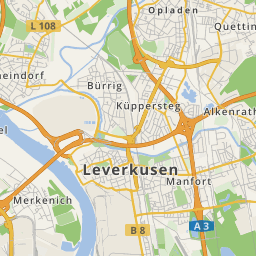











The history of the village 'Upladhin' can be traced back to the year 1168. In 1858 Opladen received the town charter.
Opladen is tightly connected with the Deutsche Bahn history. The opening of Opladen's railway station and two railway lines founded Opladen's reputation as railroader town and Opladen rose up before the neighbouring village Wiesdorf in the course of the industrialisation. This reputation as railroader town was consolidated through the construction of the central 'Reichsbahnausbesserungswerk' (railway repair plant) in the year 1903. During this time company-owned housing estate sprung up in the open countryside in Opladen.
In 1914 Opladen was appointed as district town, into which Lützenkirchen and Quettingen were incorporated in 1930. Since 1975 Opladen is a district of Leverkusen and has the city's biggest population density.
Opladen's heart is the Goethestraße, Opladen's car free shopping street, which looks back on a long tradition. For decades specialist shops have sold its wares here. Retailer, not large department stores characterises the street scene. But in the past few years Opladener worry increasingly about their shopping zone. Because retailers close their shops and so a series of empty shops are very visible right now.
An attraction in Oplanden's pedestrian zone is the glockenspiel: For the past 18 years a melody chimes for two minutes of every working day at 12noon and 3pm.
In close proximity to the Goethestraße the repair plant of the Deutsche Bahn is still working today.
The historic Wupper bridge connects in Opladen the Reuschenberg with the Birkenberg in Opladen. A statue of the bridge saint St. Nepomuk from the year 1746, watches over the state of the Wupper bridge. The Wupper bridge itself is far older. The Wupper bridge is first mentioned in the year 1307. It was a wooden bridge until 1732 and was replaced in that year through a stone arched bridge. Since 1908 an iron grate bridge runs over the river Wupper, which was renewed in 1979.
On the place of the synagogue is a memorial amidst a park today. It reminds of the synagogue, which was burned down by the National Socialists on the 10th of November 1938.
When the sun is shining the Opadener are drawn to the 'Schuster Island'. Contrary to its name the area is not an island anymore but a large meadow along the river Wupper. Every summer a big event, the beer exchange takes place here, which attracts more than 160.000 visitors from all over Germany.
The Schuster Island has also been an industrial location: At one time a textile factory stood here. Some years ago the industrial wasteland along the river Wupper was reactivated. Thus an 'industrial estate Schuster Island' was created, where some dozen small and middle enterprises are located now.